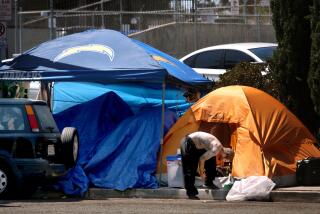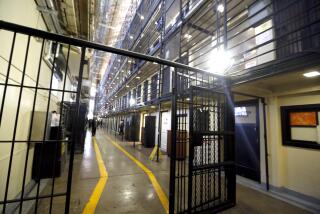Sheriff Plans Early Release of 1,000 Inmates
Los Angeles County Sheriff Sherman Block said Friday he expects to soon order the immediate release of more than 1,000 inmates awaiting trial for minor crimes and speed up by several days the release of hundreds of others who are serving time for similar crimes.
The early release plan will automatically go into effect when the county jail system’s population reaches 23,000. The eight-facility system, built to handle 12,300 inmates, now has approximately 21,700, about 3,600 more than two years ago and nearly three times the population of just eight years ago.
Shifting Prisoners
In the past, Block has used a combination of early releases, work-release plans and the accelerated processing of state parole violators to create enough room to shift prisoners between various jails when one became overcrowded.
But that flexibility is now gone, the sheriff said, blaming most of the prisoner increase on slow processing by the courts.
Despite the fact that the county has reopened three closed jail facilities, every bed in the system is full and inmates are sleeping “in day rooms, corridors, wherever beds can be placed,” he said. “It’s increased beyond what anybody could have rationally predicted. . . . It’s becoming impossible to deal with.”
The greatest number of prisoners who will be affected by the new policy are those who have been unable to make bail and are waiting for their cases to move through the court system. These prisoners will be released immediately if their charges involve nonviolent misdemeanors such as petty theft, drunk driving or narcotics, if their bail was set at less than $2,000 and if no other warrants for their arrest are pending, Block said.
He estimated that on a given day about 1,600 such people are held in county jails.
Early Release
Prisoners already serving sentences for such crimes will be released up to three days early, Block said. He estimated that could free several hundred inmates a day.
A sheriff’s spokeswoman stressed that the policy affects only those charged or convicted of misdemeanors and noted that prisoners convicted of felonies are sentenced to state facilities.
Block insisted that the early release plan will not threaten public safety. “Not with the kinds of people we’re talking about,” he said. “Most of these people would already be out if they could have raised $2,000 bail.”
A major reason for the early releases is the county’s failure to comply with an agreement between the Board of Supervisors and the American Civil Liberties Union to improve living conditions in the downtown Central Jail.
A year ago the two sides agreed to substantially lower the population of the Central Jail by nearly 50%, to 6,768. The county met a court-imposed deadline in November, in part by releasing more arrested people on their own recognizance and by expanding a work-release plan in which low-risk prisoners serve part of their sentences at home while working on county cleanup projects.
But the Central Jail population later climbed to about 8,000.
Penal Code Invoked
Several years ago, Block invoked a section of the state Penal Code, intended to help overcrowded jails, to begin releasing prisoners five days before the scheduled end of their sentences.
Block said he is able to slice three more days off sentences under another Penal Code section aimed at helping inmates prepare for their “integration” into the community.
Block has warned for years that jail facilities are intolerably crowded. Two years ago, when the system had 18,056 inmates, the sheriff said at a press conference that inmate tempers had been pushed to a “peak level.”
Last June, California voters approved a state bond measure that could eventually provide $161.4 million for new Los Angeles County jail facilities. But a later report by the county chief administrative officer said the new money would be insufficient to keep pace with inmate overcrowding or increasing court backlogs.
More recently, county court officials have said that a large increase in drug arrests, particularly for cocaine, is exacerbating the problem.
More to Read
Sign up for Essential California
The most important California stories and recommendations in your inbox every morning.
You may occasionally receive promotional content from the Los Angeles Times.










